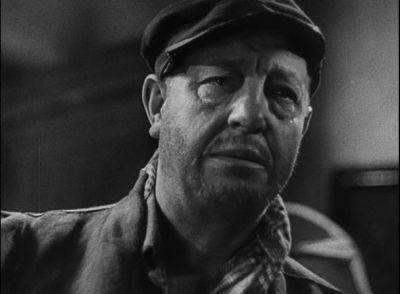
LES MISÉRABLES (Terza parte: Liberté, liberté chérie)
(I miserabili, Francia/1934) R.: Raymond Bernard. D.: 87'. V. francese. Digitale
Il migliore Les Misérables? I pochi fortunati che hanno potuto assistere all'elegante versione muta del 1925 di Henri Fescourt (presentata a Bologna nel 2004 e ora nuovamente sottoposta a un lungo e atteso restauro presso gli Archives Françaises du Film) avranno l'imbarazzo della scelta di fronte al più spettacolare film in tre parti del 1934 di Raymond Bernard, finalmente riportato a poco meno della durata originale (circa cinque ore). Se Fescourt illustrava Hugo con l'occhio di un pittore impressionista, spesso girando nei luoghi descritti dal romanzo e prendendosela comoda (ben sette ore!), Bernard, maestro del cinema spettacolare (tanto da essere soprannominato ai suoi tempi il "D.W. Griffith francese"), resta insuperato nell'equilibrio tra intimo ed epico, esibendo una ricercatezza che ha poco a che fare con il cinema standardizzato hollywoodiano. La ricostruzione dei moti del giugno 1832 è l'espressione più splendente del romanticismo di Hugo dai tempi della sequenza della doppia tempesta nel Napoléon di Gance, anch'essa ispirata da un verso di Novantatré di Hugo.
Bernard non tradisce mai lo spirito del testo letterario, neanche quando condensa e amputa interi pezzi di trama: naturalmente sono scomparse le digressioni di Hugo sui conventi e sulle origini dell'argot, la storia del sistema fognario parigino e persino la battaglia di Waterloo, che contribuiscono all'originalità stilistica del romanzo. Ma Bernard alla fine della seconda parte osa persino eliminare il malvagio Thénardier mandandolo in prigione per concentrare tutta l'attenzione sull'episodio rivoluzionario. La trovata più ispirata di Bernard - un aneddoto contenuto nel secondo volume del romanzo - si trova all'inizio del film, quando l'erculeo Jean Valjean sostiene sulle spalle la cariatide di un edificio pubblico. La metonimia dice tutto: il reietto Valjean, gargouille umana, reggerà sulle spalle e nel cuore il peso dell'azione. In maniera analoga, la celebre meditazione di Hugo, "Tempesta in un cranio", è espressa in un montaggio serrato di panoramiche verticali che mettono a nudo l'animo tormentato di Jean Valjean. Nell'episodio dei candelabri d'argento Monsignor Myriel ricorda all'ex galeotto il suo dovere morale verso il prossimo; al capezzale di Fantine morente i ceri ardono nei candelabri del vescovo; l'eroe ritrova la pace interiore proprio mentre il film trova il suo ritmo 'naturale'. Due destini sigillati in un'immagine semplice, ascetica: in ciò sta la maestria del regista.
(Béatrice De Pastre e Lenny Borger)
The best Les Misérables of them all? Those happy few who have seen Henri Fescourt's elegant 1925 silent version (shown in Bologna in 2004 and now undergoing a long overdue new restoration at the Archives Françaises du Film) will have a tough choice when they see Raymond Bernard's more spectacular three-part 1934 film, at last restored to within a few moments of its original length (only five hours). Fescourt illustrates Hugo with the eye of an impressionist painter, often filming on the very locations described in the novel and taking his own sweet time about it (seven hours!). Bernard, a master of sweeping spectacle who was dubbed the "French D.W. Griffith" in his heyday, is unsurpassed at balancing the intimate and the epic, displaying a panache that owes little to formatted Hollywood filmmaking. In itself the recreation of the June Rebellion of 1832 is the most flamboyant expression of Hugolian romanticism in film since the Double-Tempest sequence in Gance's Napoleon (itself inspired by a line in Hugo's Ninety-Three).
Bernard never betrays the spirit of the literary text even when he condenses and amputates entire chunks of plot - gone (understandably) are Hugo's digressions on convents and the origins of slang, the history of the Paris sewer system and even the battle of Waterloo, which give the novel its stylistic originality. Yet he even dares to eliminate the evil pauper, Thenardier, at the end of the second film, dispatching him to prison in order to give the revolutionary episode his fullest attention. Bernard's most inspired trouvaille - a throwaway anecdote in the book's second volume - opens the film when the Herculean Jean Valjean grapples with a caryatid on a public building façade. With this metonymy all this said: Valjean, the social pariah, the human gargoyle, will bear the brunt of the action on his shoulders and in his heart. Similarly, Hugo's famous meditation, "Tempest in a Skull", is expressed in a tumult of rapidly edited tilt shots that lay bare Jean Valjean's tortured soul. With the fall of the silver candlesticks, Monseigneur Myriel reminds the ex-convict of his moral duty to others; the candles go out as Fantine lays dying; the hero recovers inner peace at the same time as the film finds it 'natural' rhythm. Two destinies are sealed in this simple, ascetic image: Therein lies the filmmaker's mastery.
(Béatrice De Pastre and Lenny Borger)

Aria condizionata
Accesso disabili
Tel. 051 522285











